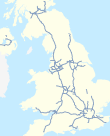East Cross Route
This article needs additional citations for verification. (December 2012) |

East Cross Route (ECR) is a dual-carriageway road constructed in east London as part of the uncompleted
Route
At its northern end, the ECR (A12) follows part of the route of the former
At Bow Road, the junction with the
South of the
History
The ECR and the other roads planned in the 1960s for central London which formed Ringway 1 of the London Ringways scheme had developed from early schemes prior to the
At the northern end of the ECR, the unrealised plans would have seen it connect at Hackney Wick to the unbuilt
Had the North Cross Route been built incoming traffic from the M11 would have been able to continue west from Hackney Wick junction on a motorway standard road past Dalston, Highbury, Camden Town, under West Hampstead to Kilburn (where a link to the M1 would have been built) and then west to Harlesden, where it would have connected with the West Cross Route, running south to connect with the A40, A4 and on to cross the Thames to connect with the South Cross Route.
Also at Hackney Wick a route was proposed running across Victoria Park to Bethnal Green; it would have then run over the Regent Canal to finish at the Angel, Islington, here it would have met the A1 road.
It is probable that this road would have been named "Eastway" to form a pair with the Westway now which performs a similar function from Paddington to White City and, in fact, a short section of road adjacent to the ECR north of the Hackney Wick junction does bear this name today.
At the southern end of the ECR, the plan was to connect it at Kidbrooke to the
Without the construction of the other parts of the 1960s motorway plans the context of the ECR has been lost in the subsequent road renumbering and the only section of the East Cross Route which continues to carry the name is the former northern motorway section of the route in Hackney Wick.
Parts of the route, at the northern end between Hackney Wick and
See also
References
- ^ "Motorways, London". Parliamentary Debates (Hansard). 7 June 1967. Retrieved 21 December 2012.
- ^ "London Motorway Box". Parliamentary Debates (Hansard). 20 March 1973. Retrieved 21 December 2012.
External links

